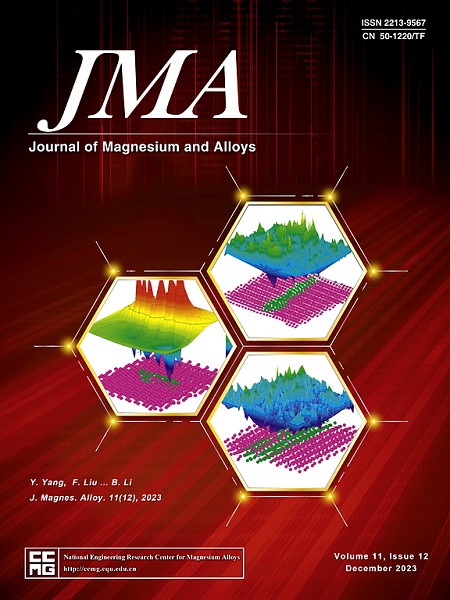Precipitation characteristics and short-time aging treatment of Mg-Gd-Y-Zn-Zr alloy
IF 13.8
1区 材料科学
Q1 METALLURGY & METALLURGICAL ENGINEERING
引用次数: 0
Abstract
Currently, Mg-Gd-Y-Zn-Zr alloys face the issue of a long aging duration. To establish a short-time aging treatment route, the precipitation characteristics and their effects on mechanical properties during elevated-temperature heat treatment prior to low-temperature aging treatment, low-temperature single-stage aging treatment, and low-temperature two-stage aging treatment were studied. The following results were obtained: Wider intragranular lamellar phases, including 14-LPSO and γ′′ phases, are more easily obtained during long-term holding at heat treatment temperatures of 400 °C and 450 °C. Although these lamellar phases do not contribute to strengthening, they enhance ductility by hindering crack propagation. Micro-sized β phases precipitate more readily at heat treatment temperatures of 300 °C and 350 °C. Intragranular needle-like β phases are not effective strengthening phases, and β phase precipitating along grain boundaries form a networked distribution, which reduces ductility. The nano-sized β' phase, as the main strengthening phase, is more likely to precipitate during single-stage aging at temperatures of 200 °C and 250 °C. The β' phase formed at 200 °C is denser, leading to higher strength, but requiring a longer aging time. For two-stage aging, which involves a primary-stage at 200 °C for 8 to 12 h followed by a second-stage at 250 °C for 10 h, the aging time is reduced to at least one-quarter of that required for single-stage aging at 200 °C, ensuring strength while improving ductility. The formation of very dense nano-sized β' phases during the primary-stage aging facilitates the densification of β' phases during the subsequent second-stage aging. Additionally, the shortened aging time hinders the precipitation of β phase along the grain boundaries, thus improving ductility.

Mg-Gd-Y-Zn-Zr合金的析出特性及短时时效处理
目前,Mg-Gd-Y-Zn-Zr合金面临着时效时间长的问题。为建立短时时效处理路线,研究了低温时效处理前的高温热处理、低温单段时效处理和低温两段时效处理的析出特征及其对力学性能的影响。在400°C和450°C的热处理温度下,长期保温更容易获得更宽的晶内片层相,包括14-LPSO和γ”相。虽然这些层状相无助于强化,但它们通过阻碍裂纹扩展来提高延性。在300℃和350℃的热处理温度下,微尺寸β相更容易析出。晶内针状β相不是有效的强化相,沿晶界析出的β相呈网状分布,降低了晶粒的延展性。在200℃和250℃单段时效过程中,纳米级β′相作为主要强化相更容易析出;在200℃形成的β′相密度更大,强度更高,但需要更长的时效时间。对于两阶段时效,包括在200°C下进行8至12小时的初级阶段,然后在250°C下进行10小时的第二阶段,时效时间至少减少到200°C单阶段时效所需时间的四分之一,在保证强度的同时提高了延展性。在初级时效阶段形成致密的纳米级β′相,促进了随后的第二阶段时效过程中β′相的致密化。此外,时效时间的缩短阻碍了β相沿晶界的析出,从而提高了塑性。
本文章由计算机程序翻译,如有差异,请以英文原文为准。
求助全文
约1分钟内获得全文
求助全文
来源期刊

Journal of Magnesium and Alloys
Engineering-Mechanics of Materials
CiteScore
20.20
自引率
14.80%
发文量
52
审稿时长
59 days
期刊介绍:
The Journal of Magnesium and Alloys serves as a global platform for both theoretical and experimental studies in magnesium science and engineering. It welcomes submissions investigating various scientific and engineering factors impacting the metallurgy, processing, microstructure, properties, and applications of magnesium and alloys. The journal covers all aspects of magnesium and alloy research, including raw materials, alloy casting, extrusion and deformation, corrosion and surface treatment, joining and machining, simulation and modeling, microstructure evolution and mechanical properties, new alloy development, magnesium-based composites, bio-materials and energy materials, applications, and recycling.
 求助内容:
求助内容: 应助结果提醒方式:
应助结果提醒方式:


